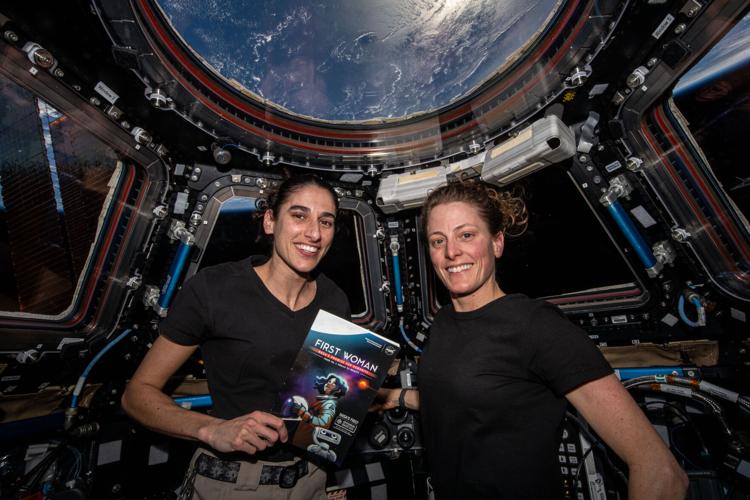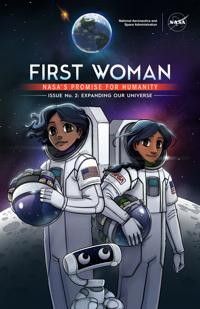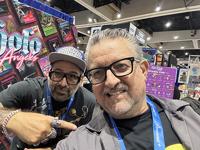
NASA Astronauts, Jasmin Moghbeli (left) and Loral O’Hara (right) with issue one of First Woman. Photo courtesy of NASA.
Only 9% of the individuals who have journeyed to space have been women, and no women have stepped foot on the Moon. But through Artemis, NASA’s mission to land the first woman and the first person of color on the Moon, the space administration is actively working to change that.
As of March 2023, out of the 676 individuals who have journeyed to space, 72 of them have been women, with 44 of them working on the International Space Station as long-duration expedition crew members, as visitors on space shuttle assembly flights or as spaceflight participants on short-duration missions, according to NASA.
“I equate the Artemis mission to our generation’s new Apollo [Program],” said Derek Wang, NASA’s Space Technology Mission Director. “My grandparents and my parents were able to witness the first moon landing live. Within the next few years, this generation will see the first person of color, and, of course, the first woman to set foot on the Moon. Our job as a team here is to help tell that story. To excite, inform and connect, hopefully, with the future generations who will carry on the legacy we're building. To continue to explore space.”
Before NASA accomplishes its goal of getting the first woman and person of color on the Moon, they want to prepare and encourage the next generation for the incoming journey with “First Woman: NASA’s Promise for Humanity,” their first-ever graphic novel. “First Woman” follows Commander Calista Rodriguez, aka Callie, as she trailblazingly becomes the first Afro-Latina to step foot on the Moon with the company of her robot sidekick, RT. With two issues out and available to read and experience, readers can follow the two as they overcome setbacks and her childhood dream along the way.
“The message of having the first woman and the first person of color as part of the program to set foot on the Moon will hopefully continue to bring excitement and inspiration,” Wang told CALÓ News. “If it's not at NASA, maybe it’s just looking up at the stars or continuing areas of business, art, design or whatever it may be. All of those pieces are important to us being successful here at NASA as a whole.”
With the inspiration to create their first-ever graphic novel, creating the 40-page project was a meticulous process for the almost fully female-led team of editors, designers and developers. Written by Brad Gann and Steven List, and illustrated by Brent Donoho and Kaitlin Reid, in order to create a protagonist and understand the challenges she’d undergo, the duo interviewed past astronauts and spoke with current NASA experts to get the administration’s history down pat. Developing Callie, which took a few months, was not only about her life as an astronaut but as an Afro-Latina as well.

The English cover of First Woman’s second issue, “Expanding Our Universe.” Photo courtesy of NASA.
“We thought it would be great to highlight an Afro-Latina astronaut because, in a sense, she is the first,” Wang said. “Looking at our astronaut corps, we have a very talented and diverse astronaut corps, but we do not have an Afro-Latina yet. We thought this would be a great way to inspire conversation and highlight how we are bringing in great astronauts who are from very different backgrounds. We knew that it could provide a very good story as well about how people of mixed cultures and mixed races can be a part of the NASA mission.”
Despite being a fictional story, the foundation of “First Woman” is grounded fully on science which required in-depth research, leading to the beat sheet – an outline of points that would take place within the novel. From there, the production team asked themselves the important questions; will this resonate with the audience? How can we push it further? How can we increase the drama or the conflict to make it a page-turner and something that people would want to keep reading? After seven months, once the script was edited and finalized, the first issue, “Dream to Reality,” was launched on September 25, 2021, also known as National Comic Book Day.
“First Woman,” now consisting of two issues with the addition of, “Expanding Our Universe,” launched in October 2023, is a multifaceted project with an expansive ecosystem of digital content. An extended-reality (XR) app for both Apple and Android, which allows readers to immerse themselves in Callie’s experience, a graphic novel, a microsite and an audiobook. Megan Thiesling, the director of creative productions and the global operations lead at bully! entertainment, oversees the ecosystem. Brought in by NASA, Thiesling entered to make sure all said aspects spoke with one another fluently and had a similar brand.
“One of the things that the team, not just me, did really well was pull our areas of expertise together really nicely,” Thiesling told CALÓ News. “Working with the NIA [National Institute of Aerospace], Derek and [the rest of] the team to make sure it told the NASA story, as well as leaning on my team at bully! entertainment to help with the creative and the storytelling to ensure that we had it grounded in the thread that would pull everything together.”
Although “First Woman” is NASA’s first try at a graphic novel, they have proven that Callie’s story, albeit fictional, is one only they can tell. It was while writing the script and asking the questions “What are the beats? The problems? The solutions? What are the technologies?” that the team realized that there was more science than fiction involved.
“We can get perspectives from our very talented scientists, engineers and astronauts that can provide us some intel and insight information to tell these stories,” Wang said. “Yes, this is a fictional story, but you can see there are a lot of touch points to the technology development, the science we're conducting on the Moon, and the people that are happening are very similar happenings throughout the agency.”
Not only is it important to the administration to tell their own story, but inspiring the next generation is a pillar of NASA’s “First Woman.” Callie, who is standing on the shoulders of the women before her who established firsts of their own, is just a promise of what’s to come in 2024, the year NASA plans to return astronauts to the Moon, and an inspiration for the younger generation. And for Thiesling and Wang, who both have young children of their own, having this character for them to aspire to is heartwarming.
“From a NASA perspective, we're excited to highlight and talk about the Artemis program and its mission and inspire the next generation,” Wang said. “We're going to have to continue to bring in the bright students and those who want to engage in various aspects of how NASA functions to be able to continue to explore further. But in a personal aspect, I am also a girl dad, with my oldest being my daughter. Also, being half Mexican and half Thai Chinese, I’m hopefully inspiring her and her two brothers about the diversity, inclusivity and diverse thought and background that makes NASA a great place to work, but also a great inspiration point of how we are to be successful in the future.”

The English and Spanish versions of First Woman’s second issue, “Expanding Our Universe.” Photo courtesy of NASA.
Members of the next generation that NASA is hoping to encourage and inspire with “First Woman”are those within STEAM, which is STEM – science, technology, engineering and mathematics – with the inclusion of the arts. The next extraordinary engineer, who might be sitting in high school right now, according to Thiesling, could be the next person to develop new innovative technology at NASA in five to 10 years.
“[‘First Woman’] is going to carry us through for this next generation and hopefully inspire people to become part of the mission, and not necessarily just to be aware of it,” Thiesling said. “What's also really cool about the graphic novel itself is that it’s not just a print graphic novel, right? It's an interactive XR-enabled graphic novel. We're not just telling the story, but we're innovating through the story that we're telling to inspire the innovators who hopefully will contribute to the Artemis mission one day.”
Along with being diverse and inclusive, the team behind “First Woman” has made it a point to be as accessible as possible. When the first issue was launched in 2021, the focus was ensuring that those who were visually impaired were able to experience the graphic novel. This led to the SoundCloud audio version with various voice talents that lifted the words off of the pages. When it came to the second issue last October, “First Woman” became a fully immersive experience in both English and Spanish, which doesn’t end at the novel; the XR app is also dual language.
“We are prioritizing our content to ensure that we reach the widest audience, and we were able to build upon the first edition and the popularity that we are creating and put out more content this go-around for our Spanish-speaking audience,” Wang said. “We will go back to creating the audio content that was also very popular, but everything is prioritized by what our resources are. NASA also works with other countries and other space nations, and there's a lot of interest in translating our content into different languages to extend the Artemis story to other countries who are supporting the mission. Artemis is going to need the support of all countries around the world, not just the United States.”
In the second issue of “First Woman,” not only do we get to continue Callie and RT’s treacherous journey on the Moon, but we are also introduced to Native American astronaut Meshaya Billy and Canadian astronaut Martin Tremblay, the new members of Callie’s team. The increased representation of female characters both depicts the diversity of the NASA team and is meant to inspire young women of color to join the administration if they are interested.
“As a female, as a Latina, as anybody, hopefully, they find inspiration in the different pieces, the different facets of what NASA is, what NASA could be and what NASA is doing so that they can find their piece or their role if they ever wanted to join us,” Wang said. “Or, to Megan's point, expand into the science, technology, engineering or mathematic fields because, then again, it would allow our world to be a better place when women, young females or persons of color can accelerate and expand our accomplishments in those particular areas.”
Amidst the representation, accessibility and inspiration for the next generation, getting to know themselves and connecting to the different storylines was just a bonus for the team behind NASA’s graphic novel. “It was more than just telling the NASA story in the end. And now, being able to carry that even further and add new team members, being able to be more inclusive and introducing a new character, we just continue to get excited about how many touch points and opportunities there are through this story alone to expand and reach out to others.”
Thiesling continued, “[Callie] resonates with me, and I'm hoping other people get the same feeling that I do, because of her grit and perseverance. Especially in issue one, being able to make mistakes and then overcome and persevere and continuously not letting small things take you off your route. I think, if that's what we can inspire in young women, including my daughter, that is such an accomplishment to me.”
If you are interested in reading “First Woman: NASA’s Promise for Humanity,” make sure to follow Callie’s journey in issues one and two – while keeping a lookout for issue three, which is coming soon. You can read, listen and download the graphic novel on NASA’s website, as well as download the XR app on Apple and Android. The app allows readers to explore the lunar surface through 5 life-size environments, interact with 3D models of real NASA technology, go behind the scenes with RT to see the latest innovations in space exploration and complete challenges to become a “First Woman” Mission Specialist.















(0) comments
Welcome to the discussion.
Log In
Keep it Clean. Please avoid obscene, vulgar, lewd, racist or sexually-oriented language.
PLEASE TURN OFF YOUR CAPS LOCK.
Don't Threaten. Threats of harming another person will not be tolerated.
Be Truthful. Don't knowingly lie about anyone or anything.
Be Nice. No racism, sexism or any sort of -ism that is degrading to another person.
Be Proactive. Use the 'Report' link on each comment to let us know of abusive posts.
Share with Us. We'd love to hear eyewitness accounts, the history behind an article.